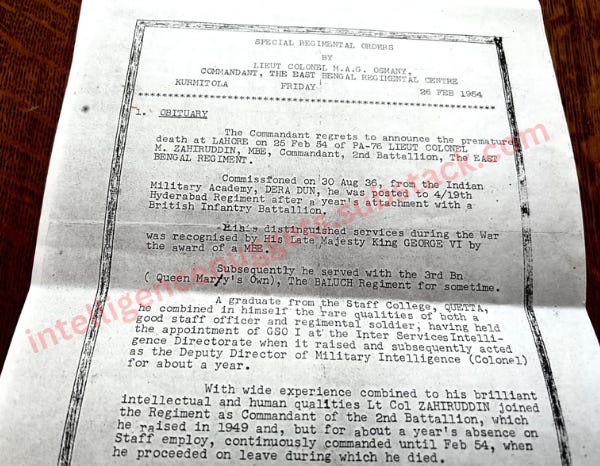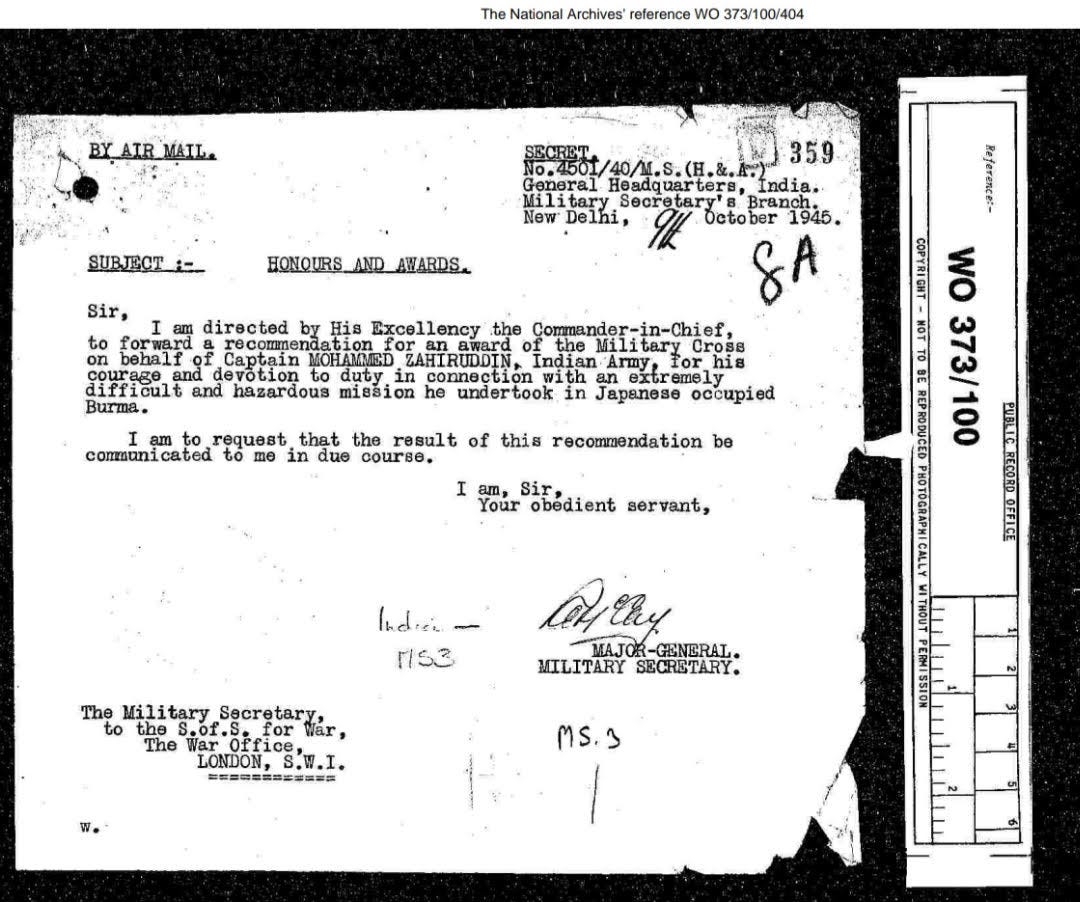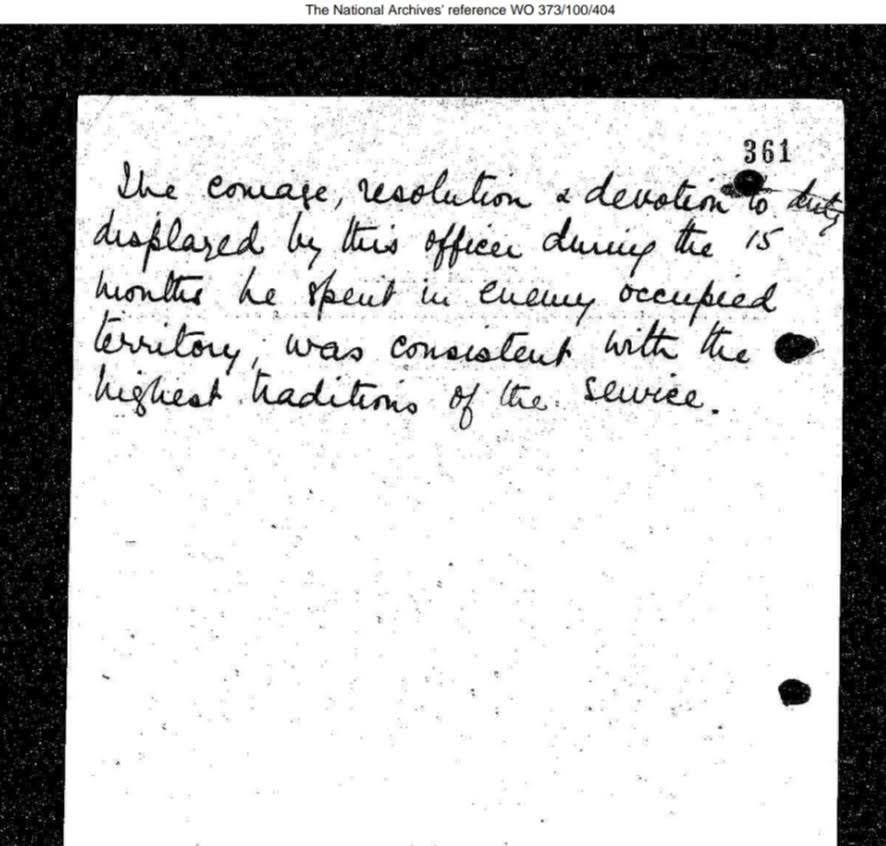Disclaimer: This profile was updated in September 2024 incorporating some previously-unknown primary information shared by the late officer’s immediate family based in the US.
Lieutenant Colonel Mohammed Zahiruddin MBE was a military officer who served in the Royal Indian Army and later in Pakistan Army. He was a renowned intelligence operator who enjoyed the confidence of both his British imperial and later Pakistani superiors.
Known Professional History:-
Commissioned as an officer in the Royal Indian Army's 4th Battalion (Ahirs) of 19th Hyderabad Regiment on 30 August 1936. As a young Lieutenant, he was sent alongside troops as part of Force EMU (Experimental Military Unit) 12th Brigade to fight against the Japanese in Malaya/ Singapore (August 1939). Instead, he was spotted conducting anti-British activities and was sent back to India for investigation; his battalion fellows (Ahirs) threatened mutiny unless he was reinstated, and so he was (May 1940).
As a Captain, he changed his views and was spotted by Brigadier Walter Joseph Cawthorne, later one of the co-founders of Pakistan's ISI and also Australian Secret Intelligence Service. At the time, Cawthorn was serving as Director Military Intelligence to Commander-in-Chief India General Archibald Wavell, concurrently also Commander of Allied Forces in the South-West Pacific. Cawthorn was directed to work with the British Secret Intelligence Service officer Colonel Peter Fleming to coordinate propaganda against the Japanese forces. Cawthorn handpicked Zahiruddin who was recruited into Fleming's GSI(d) or 'D Division', responsible for strategic deception and assigned the codename 'BACKHAND'. He was airdropped into north Burma (February 1944) and managed to gain proximity to Subhash Chandra Bose.
In fact, Bose trusted him so that he tasked Zahiruddin to conduct propaganda broadcasts for his organisation (June 1944). A few months later, however, Bose grew suspicious of Zahiruddin who used these broadcasts to signal updates to D Division after which he was arrested and thrown in a concentration camp. When Allied forces recaptured Burma, Zahiruddin was rescued at priority from Rangoon and given a hero's welcome by Cawthorn. He would receive a Most Excellent Order of the British Empire (MBE) from the late King George VI and eventually promoted to Major rank (1945). Subsequently, Zahiruddin was transferred to 3rd Battalion (Queen Mary’s Own) in the Baluch Regiment for some time.
After partition of the Indian Subcontinent, Zahiruddin opted for Pakistan where he was appointed Commandant of the School of Military Intelligence (1947-48). Upon promotion to Lieutenant Colonel, he was deputed to nascent Inter-Services Intelligence (ISI) in Karachi as General Staff Officer-I (GSO I)* and reported to its co-founder and first Director, Brigadier (later Major General) Syed Shahid Hamid (1948-1950). In 1949, Zahiruddin raised the 2nd Battalion of his new fraternity, the East Bengal Regiment.
He was appointed Deputy Director of Military Intelligence (Colonel) during tenure of Pakistan Army Commander-in-Chief General Sir Douglas Gracey and subsequently served under General Ayub Khan, the first indigenous Commander-in-Chief. He was barely a year into his position that the infamous Rawalpindi Conspiracy was unravelled and botched. After thorough criticism from Ayub, Pakistani military historian Major General (Retd) Syed Ali Hamid claims that Zahiruddin was demoted for allegedly failing to detect the brewing conspiracy. Hamid adds that Zahiruddin could not withstand the disgraceful treatment and allegedly committed suicide.
Zahiruddin’s immediate family confirmed to this author that he was found dead at a famous hotel in Lahore under unusual circumstances on 25 February 1954. Even today, the cause of his death remains a mystery.
Brigadier Hamid as ISI chief was quoted as saying that Zahiruddin had "great depth of knowledge, sincerity of purpose and dedication. He was most unconventional, an introvert, and morose....He had an analytical mind, his appreciation of a situation was faultless and his conclusions were always solid".
Zahiruddin’s immediate family graciously shared the copy of a Special Regimental Order issued the day after his death which includes a brief profile of the late officer.
It confirms service in the MI as a Deputy Director (Colonel), suggesting that he was indeed demoted/ reverted to Lieutenant Colonel rank later. His official obituary remembers him as someone who "combined in himself the rare qualities of both a good staff officer and regimental soldier".
This regimental obituary was issued by Lieutenant Colonel M.A.G. Osmany (Mohammad Ataul Gani Osmany), then Commandant of East Bengal Regimental Centre in Chittagong (1953-54) who later rose to become 1st Commander-in-Chief of independent Bangladesh.
It is interesting to note that Osmany had also been caught up, though indirectly, in the infamous Rawalpindi Conspiracy saga.
Ishfakul Majid was senior to Ayub and was the first officer from Bengal to reach Major General rank. He was superseded by Ayub who as Commander-in-Chief mistreated him and accused him of unproven complicity in the Rawalpindi Conspiracy, prompting a strong resentment from Osmany; he was eventually removed from his parent unit (14 Punjab Regiment) and posted as the third (and first Bengali) Commanding Officer of 1st East Bengal Regiment.
Citation Records for Zahiruddin’s MBE
Hat-tip to Tom Griffin for sharing the declassified copy of this citation from the British National Archives.
Summary of Updates/ Corrections/ Amendments - September 2024
Gist of previously-unknown details (these are, of course, not part of the author’s research compiled from open sources) graciously shared by Zahiruddin’s immediate family:
He was at the rank of Lieutenant Colonel (not Major as earlier believed) at the time of his death and recognised as such in the Special Regimental Order of 26 February 1954.
He was transferred from Hyderabad Regiment to Baluch Regiment and later to the East Bengal Regiment in erstwhile East Pakistan.
He helped raise 2nd Battalion of East Bengal Regiment.
Subsequent to the ISI, he was appointed Deputy Director (Colonel) in the Military Intelligence Directorate, GHQ and not Director (as earlier believed).
References
Kaushik Roy, 'Battle for Malaya - The Indian Army in Defeat, 1941-1942'
Thaddeus Holt, 'The Deceivers: Allied Military Deception in the Second World War'
Major General Syed Ali Hamid, 'Early Years of the ISI', https://thefridaytimes.com/07-May-2021/early-years-of-the-isi
Owen L. Sirrs, 'Pakistan's Inter-Services Intelligence Directorate: Covert Action and Internal Operations'
Andrew Selth, 'Race and Resistance in Burma, 1942–1945', Modern Asian Studies Vol 20 Issue 3, Cambridge University Press, https://www.cambridge.org/core/journals/modern-asian-studies/article/race-and-resistance-in-burma-19421945/F5CC65CC035A1756D99D06FF4BBE5130
Alan Ogden, 'Master of Deception - The Wartime Adventures of Peter Fleming'
Mihir Bose, 'Silver: The Spy who Fooled the Nazis : the Most Remarkable Agent of the Second World War'








